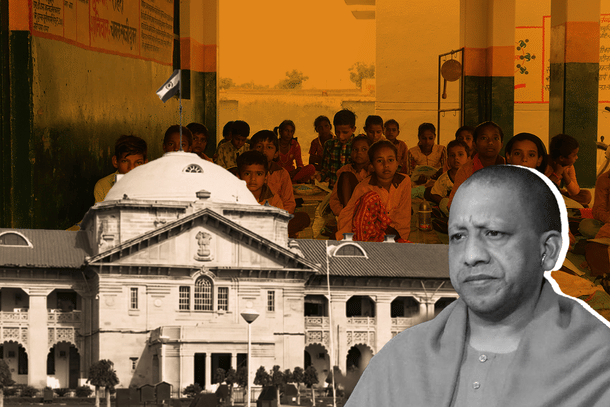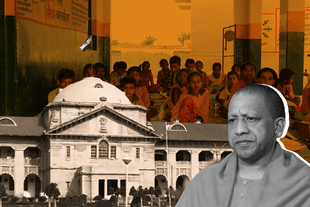Uttar Pradesh
Uttar Pradesh's School-Merger Plan May Be Rational, But Is It Practical?
Nishtha Anushree
Jul 12, 2025, 01:10 PM | Updated 01:11 PM IST
Save & read from anywhere!
Bookmark stories for easy access on any device or the Swarajya app.


The Uttar Pradesh (UP) government achieved success on the legal front earlier this week when the Allahabad High Court dismissed petitions against its decision to merge schools with low student enrolment.
In an order dated 16 June, the UP government laid out a structured plan to merge (officially termed 'pair') government primary and upper-primary schools with fewer than 50 students into nearby larger institutions.
Two petitions were filed against this order in the Allahabad High Court, one by a group of 51 students from a primary school in Sitapur and one from the upper primary section.
The court clubbed the two petitions for hearing. After a two-day detailed hearing on Thursday and Friday, the court delivered its judgment on Monday (7 July) in favour of the UP government.
While the judgment dismissed the petitioners' argument that the merger order violates the Right to Education (RTE) Act and Article 21A of the Constitution, the UP government has a long way to go in implementing the commitments it made in court.
The UP Government's Rationale
To support its case in court, the UP government cited examples of 58 primary schools with zero enrolment, as well as those with fewer than 15 students, and explained how these students are deprived of the facilities available in larger schools.
Representing the government, Additional Advocate General (AAG) Anuj Kudesia and Chief Standing Counsel (CSC) Shailendra Kumar Singh argued that the move is in the broader interest of students who would receive better exposure.
They claimed that the merger would provide improved infrastructure, more social interaction and holistic development with a more structured academic environment, better teacher-student interaction and optimised resource use.
The state lawyers also asserted that the move is about pairing, not closure. No schools would be shut down, only students from low-enrolment schools would be shifted to larger institutions.
What the Petitioners Argued
Senior advocate L P Mishra and advocate Gaurav Mehrotra, representing the petitioners, based their argument on the UP Right of Children to Free and Compulsory Education Rules 2011, which state there should be a primary school within one kilometre of any population cluster of at least 300.
They also argued that Article 21A of the Constitution guarantees the right to free and compulsory education for children between the ages of six and fourteen years. Therefore, it is the state government's responsibility to ensure access to schools.
"It makes primary education a fundamental right and makes the state duty-bound to provide free and compulsory education to all eligible children. This right cannot be waived. The government is duty-bound to create resources for schools within these parameters," Mishra said.
Concerns were also raised about the distance young children would have to travel if their local schools were closed. Mehrotra argued that fundamental rights could not be altered through executive orders.
What the High Court Said
The order passed by Justice Pankaj Bhatia cited the National Education Policy (NEP) 2020 and found no merit in the petitions, stating there was "no material to the contrary in respect of guidelines of pairing in the policy of 2020, which can be said to be arbitrary or in violation of Article 21A of the Constitution."
Instead of relying solely on the distance limits prescribed in the UP Education Rules 2011, the court adopted a broader view, keeping all clauses of the Act in mind. It concluded, "It is the duty of the State Government to establish schools as far as practical at a distance which is closest to the habitation."
It urged the state government to provide facilities such as transportation and to identify another available school in the neighbourhood, whether government or non-government, if it is not feasible to establish a new school in the locality.
Considering the large size of Uttar Pradesh, availability of land and other resources, and the state's fiscal health, the court dismissed the petitions against the merger of schools.
NEP Over RTE Act?
The order has raised questions about why the court gave greater weight to the NEP than the RTE Act. Notably, the RTE Act "deliberately does not define the limits or area of neighbourhood as a centralised norm" and leaves it to individual states.
It recommends distance norms of one kilometre for children in classes 1 to 5, and three kilometres for classes 6 to 8. The UP government has adopted this recommendation but with certain clauses allowing it to bypass these limits under specific conditions.
The court noted that, with a population of approximately 24 crore, if the petitioners’ argument for a school for every 300 inhabitants were accepted, the state would have to provide about eight lakh schools, which would be unfeasible.
Based on these clauses, the court ruled in favour of the government. On the other hand, NEP 2020 provides clearer recommendations for establishing school complexes to ensure vibrant teacher communities and better subject-wise teacher deployment.
The NEP also recommends rationalising schools for "effective school governance, resource sharing, and community building" without compromising accessibility. It presents data on how small school sizes have made it economically inefficient and operationally difficult to run high-quality schools.
To address this, the NEP proposes a grouping structure called a school complex, comprising one secondary school and all neighbouring schools offering lower grades. The court therefore accepted the UP government's NEP-based argument.
Convenient Selectivity?
It was argued in court that the UP government is opting for an "easier route" by merging schools to ensure better resource use, instead of improving resources in existing institutions.
Besides prioritising convenience, the UP government is also being accused of selectively using the NEP to gain legal leverage, without fully implementing its recommendations.
"It has been years since the NEP was introduced, but we see no changes in our education system or curriculum as recommended in the NEP. It is only being used to merge the existing schools," a government school teacher in Dadri told Swarajya.
Another teacher from Unnao pointed to another instance of selective implementation of school reforms.
She said, "Regular third-party inspections occur, but they only check superficial things like teacher attendance or school infrastructure. It is all a formality. The quality of education is never assessed."
Given that the quality of education is reportedly poor even in larger schools, concerns are growing over whether the merger will genuinely improve learning outcomes, as claimed.
Rationality or practicality?
While the Allahabad High Court adjudged the UP government’s decision rational, this does not guarantee its effectiveness in practical sense.
"Distance plays a very crucial role when we want children to come to school. With the merger, the distance will increase, resulting in higher dropout rates," said the teacher from Dadri.
The teacher from Unnao observed that the quality of education in a nearby small school and a farther, larger school would be similar, providing no incentive for a child to travel further.
"It is already very difficult to get children to attend school. With increased distances, the merger of smaller schools would effectively mean their closure," she said.
Notably, UP has historically recorded dropout rates higher than the national average, with some improvement only in recent years. The decision to merge schools may risk undoing this progress.
Furthermore, the UP government has not yet announced how it plans to facilitate student transportation to farther schools, as directed by the High Court. This has heightened existing concerns.
Apart from dropouts, questions have also been raised about what will happen to the infrastructure of merged schools. However, the UP government appears to have a plan for this.
For children aged three to six, the government plans to launch pre-primary schools known as Bal Vatikas. It is believed that the infrastructure of merged schools will be repurposed for these Bal Vatikas.
Despite such initiatives, numerous issues continue to affect government schools in UP, such as inadequate infrastructure, poor learning outcomes, and excessive administrative burden on teachers.
In this context, there is a concern that the merger may be a cost-cutting exercise rather than a genuine reform effort. Already, UP has allocated a smaller share (13.8 per cent) to education in the 2025–26 budget than the average for other states (15 per cent). The key question is whether this merger will truly translate into improved educational quality.
Nishtha Anushree is Senior Sub-editor at Swarajya. She tweets at @nishthaanushree.





